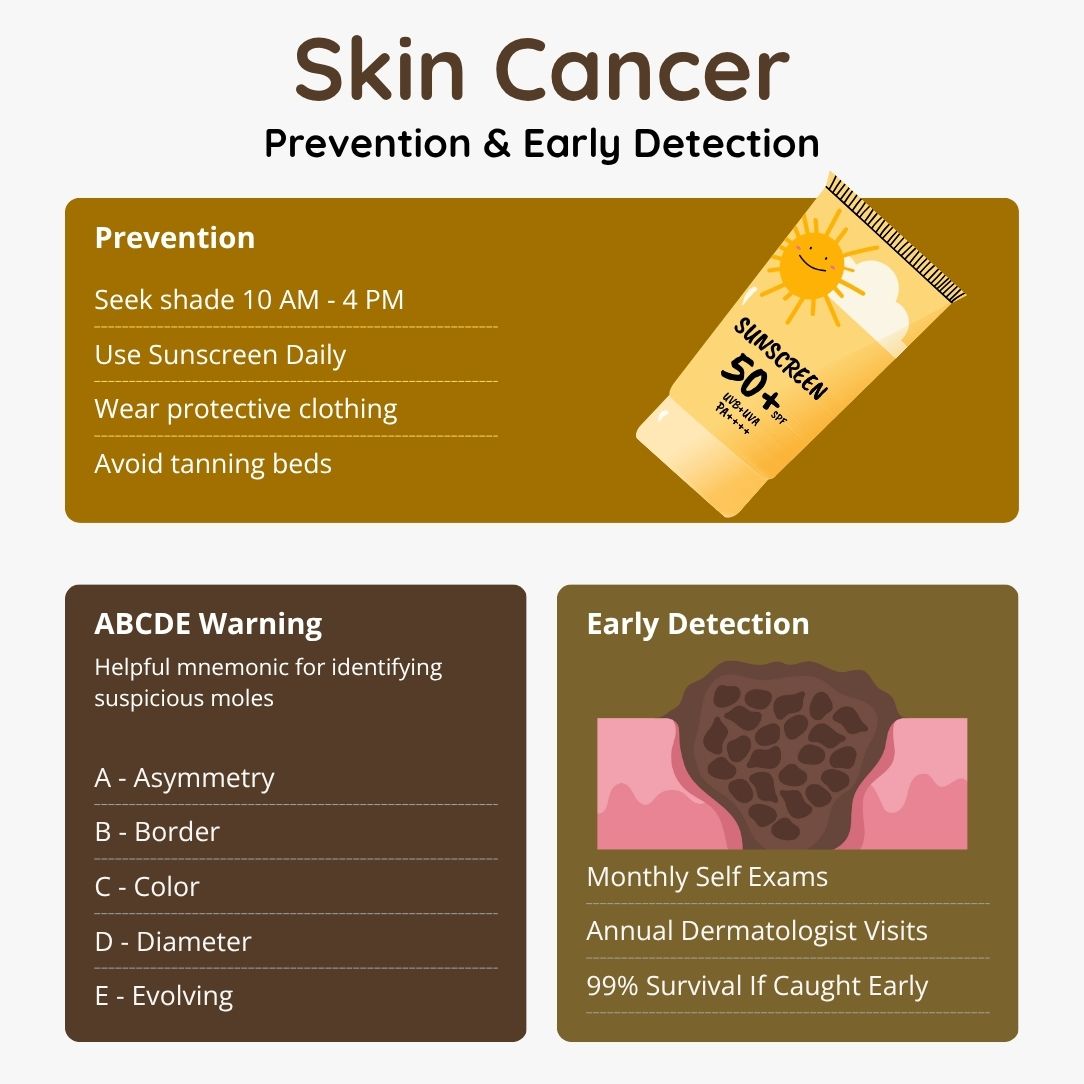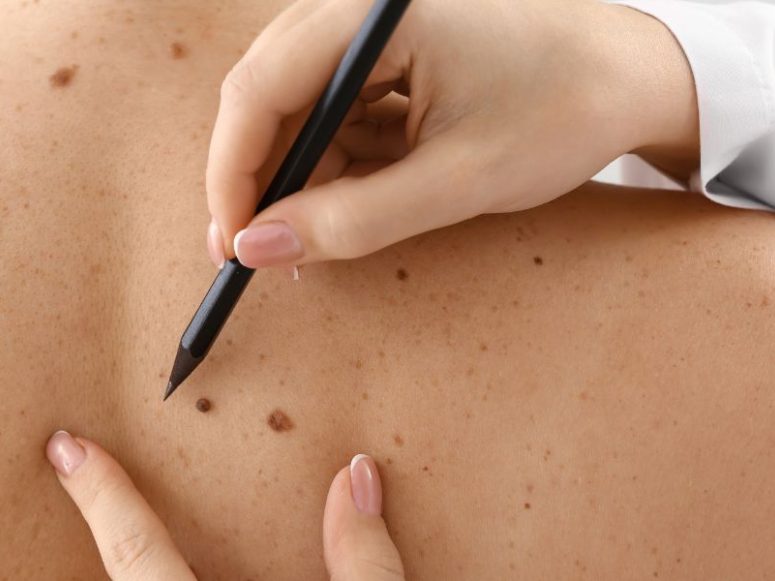Key Takeaways
- A comprehensive sun protection strategy is your best defense against skin cancer. This includes seeking shade, wearing protective clothing, and using broad-spectrum sunscreen with an SPF of 30 or higher every day.
- Early detection is critical for treating skin cancer, especially melanoma. The 5-year survival rate for early-detected melanoma is 99%, but it drops significantly if the disease spreads.
- Perform a monthly head-to-toe self-exam to look for any new, changing, or unusual spots, and see a dermatologist annually for a professional skin exam.
Enjoying the sunny days in Western New York is a pleasure, but it comes with the responsibility of protecting your skin from the harmful effects of ultraviolet (UV) radiation. Skin cancer is the most common cancer in the United States, but it is also one of the most preventable. Understanding how to protect your skin and what to look for can save your life.
At SOM Medical Practice, we are committed to providing our patients with the tools and knowledge to stay healthy. This guide offers a comprehensive approach to skin cancer prevention and early detection, so you can safely enjoy the outdoors.
1. Understanding the Risk: The Dangers of UV Radiation
UV radiation from the sun is the primary cause of skin cancer. It can damage your skin cells, leading to genetic defects that can trigger cancerous growths. This damage accumulates over time and can occur even on cloudy days or during brief sun exposure, like walking to your car [1].
It's a myth that a tan is a sign of good health. Any change in your skin color after UV exposure, whether it's a tan or a burn, is a sign of skin injury [2]. Indoor tanning beds are particularly dangerous, as they expose you to intense levels of UV radiation, significantly increasing your risk of all types of skin cancer, including melanoma.
2. A Complete Sun Protection Strategy
The Skin Cancer Foundation recommends a multi-faceted approach to sun safety. Relying on sunscreen alone is not enough.
- Seek the Shade: Limit your direct sun exposure, especially during the peak UV hours of 10 AM to 4 PM.
- Cover Up: Wear protective clothing, including long-sleeved shirts, pants, a broad-brimmed hat, and UV-blocking sunglasses. This is one of the most effective ways to shield your skin.
- Use Sunscreen Daily: Apply a broad-spectrum (UVA/UVB) sunscreen with an SPF of 30 or higher to all exposed skin every day. For extended outdoor activities, use a water-resistant sunscreen with an SPF of 50 or higher. Remember to reapply every two hours, or more frequently if you're swimming or sweating [1].

3. Early Detection: Your Best Chance for a Cure
When caught early, skin cancer is highly treatable. For melanoma, the most dangerous form of skin cancer, the 5-year survival rate is 99% if it's detected before it has a chance to spread [3]. This is why regular skin exams are so important.
- Perform a Monthly Self-Exam: Once a month, check your entire body, including hard-to-see areas like your back, scalp, and the soles of your feet. Use mirrors to help you, or ask a partner for assistance. Look for anything new, changing, or unusual.
- Know the ABCDEs of Melanoma: This simple acronym from the Skin Cancer Foundation can help you identify the warning signs of melanoma [3]:
| Letter | Meaning | Description |
| A | Asymmetry | One half of the spot does not match the other half. |
| B | Border | The edges are irregular, scalloped, or poorly defined. |
| C | Color | The color is not uniform and may include different shades of brown or black, or even patches of pink, red, white, or blue. |
| D | Diameter | The spot is larger than 6 millimeters across (the size of a pencil eraser), although melanomas can sometimes be smaller. |
| E | Evolving | The mole or spot is changing in size, shape, or color. |
In addition to the ABCDEs, be aware of the "Ugly Duckling" sign. Most normal moles on your body look similar to one another. A mole that looks different from the rest is an "ugly duckling" and should be checked by a doctor [3].
4. When to See a Doctor
If you notice any of the ABCDE warning signs, an "ugly duckling" mole, or any spot that is new, changing, or just doesn't seem right, it's crucial to see a healthcare provider promptly. While most skin spots are harmless, a professional evaluation is the only way to be sure.
In addition to your monthly self-exams, the Skin Cancer Foundation recommends that everyone see a dermatologist at least once a year for a professional skin examination [1]. This is especially important if you have a higher risk for skin cancer, which includes:
- A personal or family history of skin cancer
- Fair skin that burns easily
- A history of frequent or severe sunburns
- Many moles
5. Your Partner in Skin Health
At SOM Medical Practice, your health is our priority. Our primary care providers are trained to perform skin checks as part of your annual physical and can provide referrals to dermatologists for more specialized care. If a suspicious lesion is found, we offer in-office minor procedures like skin biopsies to provide a prompt diagnosis.
By adopting a comprehensive sun protection strategy and being vigilant about checking your skin, you can significantly reduce your risk of skin cancer and ensure that if it does develop, it's caught at the earliest, most treatable stage. Contact us today to schedule your annual check-up and discuss your skin health.
References
[1] Skin Cancer Foundation. (2025). Skin Cancer Prevention. https://www.skincancer.org/skin-cancer-prevention/
[2] Centers for Disease Control and Prevention. (2024). Reducing Risk for Skin Cancer. https://www.cdc.gov/skin-cancer/prevention/index.html
[3] Skin Cancer Foundation. (2025). Melanoma Warning Signs and Images. https://www.skincancer.org/skin-cancer-information/melanoma/melanoma-warning-signs-and-images/








